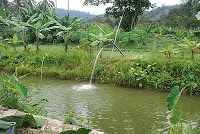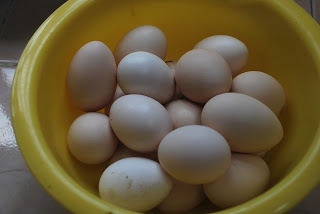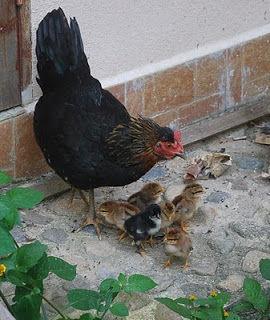Edible Landscape – Papaya Tree
 I find that the papaya is a refreshing fruit to have for breakfast and is full of vitamins with a high vitamin C content and fibre – a great way to start the day. The papaya fruit that are tree-ripened also contain the highest amount of the papain enzyme which is beneficial. The tree also makes an interesting addition to the garden, with its “fancy leaves” and based on the type, will fruit or will just have flowers. In Malaysia, the papaya trees that do not fruit but just flowers are known as Male Papaya trees and the ones the fruit are know as just Papaya trees. Its botanical name is Carica Papaya.
I find that the papaya is a refreshing fruit to have for breakfast and is full of vitamins with a high vitamin C content and fibre – a great way to start the day. The papaya fruit that are tree-ripened also contain the highest amount of the papain enzyme which is beneficial. The tree also makes an interesting addition to the garden, with its “fancy leaves” and based on the type, will fruit or will just have flowers. In Malaysia, the papaya trees that do not fruit but just flowers are known as Male Papaya trees and the ones the fruit are know as just Papaya trees. Its botanical name is Carica Papaya.
It is propagated from the seeds from the mature, ripe papaya and grows well in sunny locations with regular watering – naturally or manually. I still haven’t figured out which type of papaya tree I will get from the seed and hopefully some day, I will know what type of tree the seed will produce – fruit-bearing papaya trees or male papaya trees. On the farm, it has grown up to 10m tall, which made picking the fruit a challenge. Luckily, I have someone who is adapt at climbing it.
 |
| Fruit bearing flower |
There are many varieties of papaya and depending on the variety, the height of the tree is different. Some varieties start bearing fruit even at 1.5m tall, making it much easier to harvest. The skin of the fruit turns from green to yellow to orange as it ripens. The fleshy part of the fruit ranges in color from yellow to vermillion to red and the taste vary from one species to another. It is a plant that requires minimal care fertilisers, it is an easy plant to grow. At the farm, the life span of the plant is about five years. Even if they live more than that, by the time it is 5 years old, they are too tall for me to harvest and the quality of the fruits have diminished so I will remove it and plant a new one, As I stagger my planting them
 |
| Ready-to-eat Papaya flowers do not turn into fruits |
The papaya flowers that are eaten, either raw as ulam or cooked, appear in multiple flower buds whereas the fruit bearing flower grows as a single flower. The flowers that are eaten have a slightly bitter taste but there are ways to counteract this. If you plan on eating it raw, combine them with terung pipit or Turkey Berry. I tend to eat the young papaya leaves with terung pipit wrapped inside. The resulting taste is less bitter and I am left with a papaya after-taste – definitely more pleasant than a bitter after-taste. If you plan on cooking them, first boil them in water with senduduk hutan (Melastoma Alba) leaves and this will remove the bitterness from the papaya shoots and flowers. The resulting taste is slightly creamy papaya-like.
 The papaya shoots and flowers are traditionally used for high blood pressure and hypertension therapy and to encourage red cell production hence it is often given to someone who is recovering or fighting dengue fever. It is becoming more common in Malaysia as a supplementary treatment for dengue fever as it will help the production red blood cells faster, counter-acting the effect of dengue fever that causes a decrease in the red blood cells.
The papaya shoots and flowers are traditionally used for high blood pressure and hypertension therapy and to encourage red cell production hence it is often given to someone who is recovering or fighting dengue fever. It is becoming more common in Malaysia as a supplementary treatment for dengue fever as it will help the production red blood cells faster, counter-acting the effect of dengue fever that causes a decrease in the red blood cells.
Because of the leaves bitter taste, for people who like to juice, it is juiced with fruits like green apple and also vegetables like celery and cucumber to make it more palatable as well as adding nutritional value. Personally, I take it at least once a week to help prevent hypertension and high blood pressure as well as a blood cleanser and is in my regular diet regime since I love eating “rich” foods. The flowers can also be turned into a salad or “kerabu”, either in its raw form or blanched. The leave stem can also be eaten raw by first removing the outer skin. It has a crunchy texture and is creamy in taste and can be added to salads or eaten on its own.
The young green papaya fruit makes a delightful addition cooked in spicy dishes such as curry. It is is used to make papaya soup with a clear broth. A semi-ripe papaya can be turned into a sweet and sour pickle and sometimes, chillies are added to spice it up.
The ripe papaya is often eaten raw as a dessert in Malaysia. It can also be blended into a lovely smoothie or milk-shake. Papaya is often eaten as part of breakfast as it can help to expedite the bowel movement. A tasty papaya conserve can also be prepared from ripened fruits. The papaya peel can also be used as a facial treatment by placing them on cleansed face and leaving it for 10-15 minutes and then rinsing the face. I also use the wastes from the papaya for my beneficial microorganism fertiliser.
With all the ways to eat the fruit , leaves and flowers and the benefits, this plant is a great addition to an edible landscape.
Updated: 5 October, 2015



